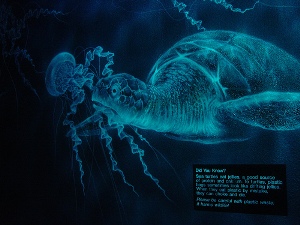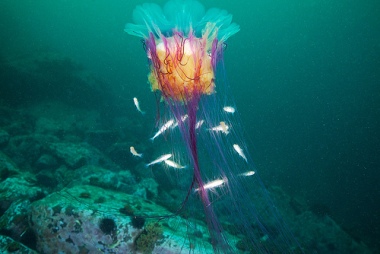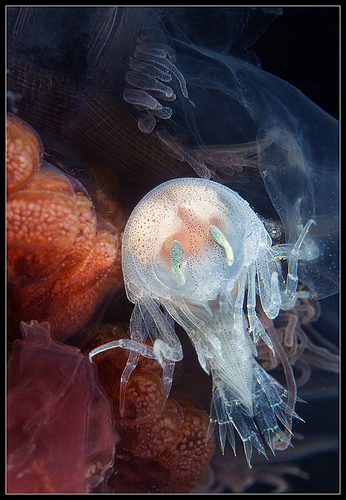Interactions
Humans
If you want to know what it would be like to get
stung by a Lion's Mane but not actually have it happen then just
keep reading! First off, if you are stung you will feel a
sharp stinging pain for about 30 seconds
after contact. Then an
excruciating burning sensation will last for around 20 minutes. This is
then followed by reddening of the skin (erythema) and also
blistering underneath if bad enough . Now don't worry if you
listen to your parents and put ample amounts of sunscreen on, you may
actually be in luck! When stung by a Lion's Mane without any
lotion/oil on the skin, studies have shown that 100% of their
Cnidocytes (stinging cells) are
triggered. Therefore, the maximum amount of venom is then released
from the nematocyst. But if you followed your parents instructions
and put sunscreen on, only 8%-39% of the cnidocytes would be
triggered! I know listening to your parents is a painful thing
in itself, but I would rather suck it up and put on the sunscreen
than feel the full wrath of the Lion's Mane Jellyfish. If
you're thinking "I'll just be really careful and look out for
jellyfish" you aren't in the clear yet! You don't just have to
worry about swimming close to a Lion's Mane. In areas where they are
abundant, there have been cases of people being stung from the
detached tentacles that got ripped off the body of the jellyfish and
caught in a net.
around 20 minutes. This is
then followed by reddening of the skin (erythema) and also
blistering underneath if bad enough . Now don't worry if you
listen to your parents and put ample amounts of sunscreen on, you may
actually be in luck! When stung by a Lion's Mane without any
lotion/oil on the skin, studies have shown that 100% of their
Cnidocytes (stinging cells) are
triggered. Therefore, the maximum amount of venom is then released
from the nematocyst. But if you followed your parents instructions
and put sunscreen on, only 8%-39% of the cnidocytes would be
triggered! I know listening to your parents is a painful thing
in itself, but I would rather suck it up and put on the sunscreen
than feel the full wrath of the Lion's Mane Jellyfish. If
you're thinking "I'll just be really careful and look out for
jellyfish" you aren't in the clear yet! You don't just have to
worry about swimming close to a Lion's Mane. In areas where they are
abundant, there have been cases of people being stung from the
detached tentacles that got ripped off the body of the jellyfish and
caught in a net.
Predators
 Even though the Lion's Mane is an incredibly
skilled predator, there are still a few things who dare eat it.
Animals like the Leather back turtles use Cyanea capillata
as a main source of food in many regions around the globe.
Another specimen that feeds on the Lion's Mane are seabirds.
When the Cyanea capillata come up to the surface (typically
more often towards the end of their life span) the seabirds can
easily come down and feast upon them. A few other predators
are larger fish and other jellyfish. You might think being so
large like the Lion's Mane might make you an easy target for
predators but they are no where near to becoming endangered.
Even though the Lion's Mane is an incredibly
skilled predator, there are still a few things who dare eat it.
Animals like the Leather back turtles use Cyanea capillata
as a main source of food in many regions around the globe.
Another specimen that feeds on the Lion's Mane are seabirds.
When the Cyanea capillata come up to the surface (typically
more often towards the end of their life span) the seabirds can
easily come down and feast upon them. A few other predators
are larger fish and other jellyfish. You might think being so
large like the Lion's Mane might make you an easy target for
predators but they are no where near to becoming endangered.
Mutualist
The Lion's Mane is known for capturing
prey with its powerful sting, but what most people do not
know is that they actually play
nice with several other organisms. The first mutual
relationship the Cyanea capillata has is with
the small crab megalops larva that lives on the outside of its bell and helps keep it
clean. The second mutual relationship it has is with
the Pilot fish. These fish are lucky enough to not be
affected by the Lion's Mane's powerful sting. This
relationship is demonstrated on the image to the right of
this text. Practicially all tropical jellyfish have a
mutual relationship with a Dinoflagellate, and Cyanea capillata
is no exception. Zooxanthellae is a Dinoflagellates that
lives inside the
jellyfish. This tiny protist creates energy from
sunlight and also organic molecules that the jellyfish
can then use. In return, the jellyfish excretes
ammonium molecules for the Zooxanthellae to use. As I
said before, this relationship is primarily in the tropical
regions and are therefore only found in the smaller Lion's
Mane jellyfish. Another important mutual
relationship the Lion's Mane jellyfish has is with shrimp.
Cyanea capillata helps protect and provide food for the
shrimp while the shrimp plays a similar role as the crab
larva.
that lives on the outside of its bell and helps keep it
clean. The second mutual relationship it has is with
the Pilot fish. These fish are lucky enough to not be
affected by the Lion's Mane's powerful sting. This
relationship is demonstrated on the image to the right of
this text. Practicially all tropical jellyfish have a
mutual relationship with a Dinoflagellate, and Cyanea capillata
is no exception. Zooxanthellae is a Dinoflagellates that
lives inside the
jellyfish. This tiny protist creates energy from
sunlight and also organic molecules that the jellyfish
can then use. In return, the jellyfish excretes
ammonium molecules for the Zooxanthellae to use. As I
said before, this relationship is primarily in the tropical
regions and are therefore only found in the smaller Lion's
Mane jellyfish. Another important mutual
relationship the Lion's Mane jellyfish has is with shrimp.
Cyanea capillata helps protect and provide food for the
shrimp while the shrimp plays a similar role as the crab
larva.
Parasite
 I
bet when you think about jellyfish, parasites
don't even cross your mind. In reality there are a few
parasites brave enough to double cross a jellyfish.
The Gooseneck barnacles are only found on the Scyphozoans,
and especially the Cyanea. The next parasite is
Hyperia galba, which is shown on the picture to the left
of this text. The topic of parasites on jellyfish are
still up for debate because we do not know much about their
relationships as of now.
I
bet when you think about jellyfish, parasites
don't even cross your mind. In reality there are a few
parasites brave enough to double cross a jellyfish.
The Gooseneck barnacles are only found on the Scyphozoans,
and especially the Cyanea. The next parasite is
Hyperia galba, which is shown on the picture to the left
of this text. The topic of parasites on jellyfish are
still up for debate because we do not know much about their
relationships as of now.
Victims
Cyanea capillata is a very efficient hunter and feeds on several different types of organisms such as the comb jellies, the moon jellyfish, arrow worms, and many others! To learn more about what the Lion's Mane feeds on visit my Nutrition page!
Are you lost? Go back to my home page!